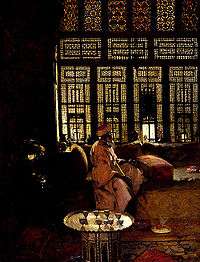Arthur Melville
Arthur Melville (1858–1904) was a Scottish painter of Orientalist subjects, among others.

Life
He was born in Guthrie, Angus in 1858 and brought up in East Lothian. He took up painting while working as a grocer's apprentice, and then attended the Royal Scottish Academy Schools before studying in Paris and Greece. The colour-sense which is so notable a feature of his work developed during his travels in Persia, Egypt and Turkey between 1880 and 1882,[1] where he sometimes travelled alone on long inland journeys. To convey strong Middle Eastern light, he developed a technique of using watercolour on a base of wet paper with gouache applied to it.
Melville, though comparatively little known during his lifetime, was one of the most powerful influences in the contemporary art of his day, especially in his broad decorative treatment with water-colour, which influenced the Glasgow Boys. Though his vivid impressions of color and movement are apparently recorded with feverish haste, they are the result of careful deliberation and selection. He was at his best in his watercolors of Eastern life and colour and his Venetian scenes, but he also painted several striking portraits in oils and a powerful composition of The Return from the Crucifixion which remained unfinished at his death in 1904. The Victoria and Albert Museum has one of his watercolours, The Little Bull-Fight Bravo, Toro! and others, like An Oriental Goatherd in the Weimar Museum, are in many museums, especially in Scotland. Many of his pictures remain with private collectors.[1]
A comprehensive memorial exhibition of Melville's works was held at the Royal Institute Galleries in London in 1906.[1]
Notes
References

- Caw, James Lewis (1912). . Dictionary of National Biography (2nd supplement). London: Smith, Elder & Co.
- Brickley, Chris. "Melville, Arthur (1855–1904)". Oxford Dictionary of National Biography (online ed.). Oxford University Press. doi:10.1093/ref:odnb/34983. (Subscription or UK public library membership required.)
External links
- Arthur Melville online (ArtCyclopedia)
- Biography of & artworks by Arthur Melville at the Gracefield Arts Centre in Dumfries, Scotland virtual representation of the Gracefield Arts Centre's Permanent Collection at exploreart.co.uk
- Passion and intrigue of an Eastern love affair - Arthur Melville's watercolours (The Independent, 13 August 1996)
- Paintings by Melville (Bridgeman Art Library)
- The Sapphire Sea (watercolour, 1892 - The Scottish Gallery)
- After the Play (Chalk - Christie's)